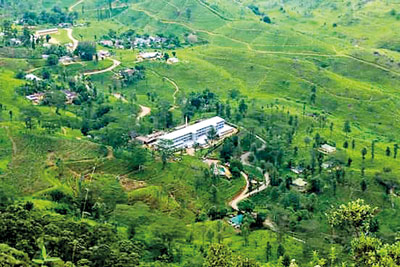Sunday Times 2
SLSPC’s silent revolution in estates from 1978 to 1992
View(s):By Rajitha Perera
My work in the Ministry of Health began as a medical officer (estate) in Kalutara. The ministry’s Family Health Bureau recruited ten medical officers (estates) for 10 plantation areas under Dr. N.W. Vidyasagara.
The Sri Lanka State Plantations Corporation had about 30 estates in the Kalutara District. I was given a van and a driver to take me and a nurse to a different estate each day. We conducted maternal and child health clinics, immunisations, child growth monitoring, and vasectomy (or male family planning). Birth control pills and IUCDs (Intrauterine Contraceptive Devices) were given to women. The nurses carried the vaccines with them. We worked alongside estate medical assistants and midwives and trained them to conduct clinics and services on their own. The services also covered the Rubber Research Institute in Dartonfield. The midwives played the most important part in the lives of women and children to improve their health.
Nihal Dias Abeysinghe was the SLSPC director for the Kalutara District, and S. Suriyamurthy was the officer assigned to work with me.
I liked the work so much that I resigned from the Health Ministry and joined the SLSPC in 1981. My wife and I lived at Talawakelle State Plantation from 1981 to 1984.

SLSPC gave top priority to estate workers’ health and education
The chairman of the SLSPC Board 11 (Nuwara Eliya, Haputale, Balangoda) was Raymond Paranavitane. Starting in the estates in Nuwara Eliya, the health services were extended to all estates in Haputale and Balangoda (about 60 estates). These were the services:
1. Weekly antenatal clinics and postnatal clinics
2. Child growth monitoring on a growth chart
3. Immunisation. “Key estates” were given refrigerators to store vaccines by UNICEF.
Mass vasectomy programmes were conducted by visiting medical officers of the Ministry of Health.
Estate medical assistants and midwives were trained to conduct the clinics. Monthly meetings were held not only for education and training but also to monitor the progress and obtain feedback.
I was invited to speak to the estate manager at monthly meetings. Raymond’s endorsement of this work meant that the support from estate managers was easily forthcoming.
With aid from the Dutch and Norwegian governments, maternity homes were built on estates. This was because pregnant mothers were reluctant to go to government hospitals and so delivered in the “line room’, in very unsanitary conditions. So, maternal and infant deaths were high.
In 1981, infant, child, and maternal deaths were the worst in estates for any part of the country. Nuwara Eliya had the worst statistics.
A new category of staff, plantation family welfare supervisors, were trained in Colombo and sent to all estates for health education. The Health Ministry trained midwives, especially for estates.
Mothers left their children in a crechec in the care of an old woman. The crèches were poorly built, and their maintenance was not a priority for management. With UNICEF providing assistance to build new crèches and train crèche attendants, children were cared for in a completely new environment. In the SLSPC (not in the Janatha Estate Development Board-JEDB), Sarvodaya trained the crèche attendants to provide quality services and meals.
Education was not considered to be important for estate children, and so estate children were lumped together in one room for a few years of education. The only priority was that they become tea pluckers and workers.
The Swiss government gave aid to build secondary schools in estates. This resulted, several years later (now), in estate children reaching university level. Such children would rather work outside estates than be treated the way their mothers were treated by “Kanganies” and estate managers.
In 1981, measles was common and rampant and took many lives of children. The measles vaccine was introduced first in Nuwara Eliya and then in all estates. This resulted in a dramatic drop in child deaths.
In 1985, Ranjan Wijeratne, then Chairman of SLSPC, invited me to head the Social Development Division of the SLSPC. At that time, grants were given by the Dutch and Norwegian governments for health and welfare as part of the Medium Term Investment Programme (MTIP). The MTIP funded all aspects of the tea and rubber industry. The health and welfare aspects were funded by the Dutch and Norwegians. The Dutch and Norwegian governments also funded technical assistants and experts from their countries to work alongside the Social Development Divisions of JEDB and SLSPC.
Ranjan Wijeatrne held the annual meetings in Colombo and invited all chairpersons and directors of the SLSPC for a day’s programme to review progress and decide on the next steps. He had the welfare of women and children in his heart, knowing full well that they were responsible for producing the ‘gold’ of the Sri Lankan economy for many years.
This included the building of toilets and new houses (twin cottages). Engineers were recruited to the Social Development Division to guide the building of toilets, water supplies, and new housing. The JEDB had similar programmes.
Within a few years, the vital health statistics of estates (birth rates, infant, child, and maternal dates) came close to those of the rest of the country. Perhaps they are better in estates than in rural Sri Lanka now.
This is perhaps a “silent” and very dramatic social revolution that helped nearly 1 million people in Sri Lanka and enabled them to have a better life. They were at the bottom of society after the English brought them to Sri Lanka as indentured labourers 200 years ago. This was the importance given to them, although they produced the “gold” of the Sri Lankan economy and also helped the English (to get cheap quality tea and rubber) who conquered our land.
Today, the young people in estates have been liberated to find their own destiny.

